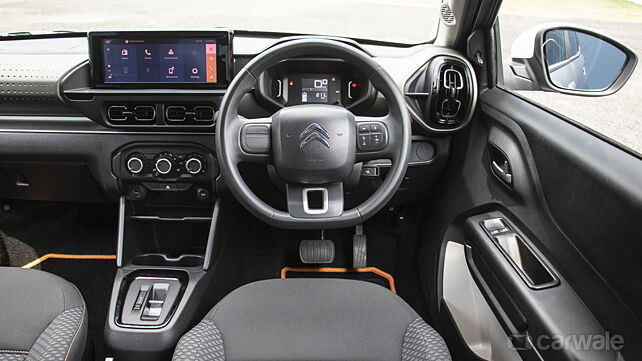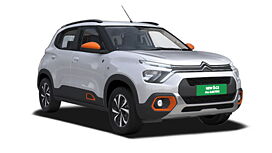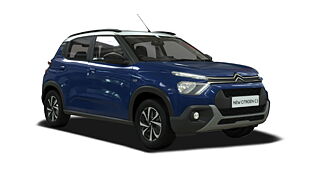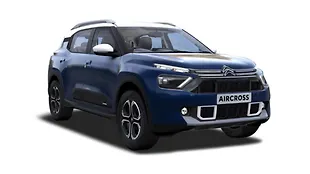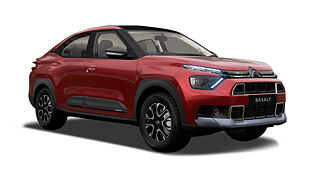Why I would buy it?
- Claimed range
- Interior space
- Funky looks
Why I would avoid it?
- Lacks essential features
- Restricted performance
What is it?
Citroen is playing the long game in India and instead of going for a model in the very competitive sub-4 B SUV segment, it has brought in a budget EV for the Indian market with the aim of being an early adopter. This EV is an electric version of their C3 hatchback and has been developed alongside the ICE version.

In terms of exterior design, this eC3 looks no different from the regular C3 and that’s because Citroen had developed both the cars side-by-side and has them underpinned by the same platform. It’s a very funky-looking car with a host of design elements to catch your attention. Up front, you get the same double-barrel Citroen logo with LED eyebrows and low-set headlamps.

In the profile, you can see the ‘e’ electric logo and heavy shoulder line while at the rear you get wrap-around tail lamps and ec3 badging as a part of the overall design. The charge port door has been fitted on the right front while the alloy wheels you see on our test car are actually accessories and in a stock form you only have wheel covers of a similar design.
Is the cabin of the Citroen eC3 any good?

Like the outside, the cabin of the eC3 is shared almost part-for-part with the ICE-powered C3. You get the same dual-tone dashboard, digital instrument cluster and fabric seats with a contrasting colour scheme. It looks and feels just like the regular C3 which should work in its favour in terms of normalising EVs and of course maintaining the brand identity that Citroen has developed with the C3.

Up front, the instrument cluster is still a basic black-and-white MID but has been slightly modified to include things like charge percentage and dual trip meters. In this top-spec Pure variant that we drove, you get a 10.2-inch display with an easy-to-use and colourful interface. The display itself is bright and clear with quick paths to all functions. It lacks any physical buttons and has a glossy finish but does come with wireless Apple CarPlay and Android Auto.

One place where the C3 and now even the eC3 score high is interior space. Having had to not build an EV into the ICE model, Citroen has packed the batteries in the wheelbase completely thus maintaining the full boot and complete engine bay. At 2540mm, it has the largest wheelbase in the segment. On the fronts of legroom, headroom and shoulder room it is very spacious, especially in the second row where three medium-sized adults can sit abreast without a struggle. However, having a battery pack underneath has resulted in a high floor for the second row and thus reduced under-thigh support. The second row is also bare bones with no armrest, a 60:40 split folding function but you do get two USB ports.

What it makes up for in space and looks, the eC3 loses out in terms of features. You get the digital cluster, touchscreen and even a very easy-to-use connected car app (My Citroen).

Still, on the flip side, the car is lacking feel-good features like projector headlamps, alloy wheels, ambient lighting, full-colour MID and climate control. You only get two airbags in both variants. At the time of doing this review, neither the C3 nor eC3 had been tested for a GNCAP safety rating.
Is the Citroen eC3 nice to drive?

The eC3 is powered by a permanent magnet synchronous motor producing 56bhp/143Nm and mated to a single-speed transmission powering the front wheels. You get two driving modes-Standard and Eco and a regeneration function for sending charge back to the battery pack. Crucially, you get a 29.2kWh battery pack giving you a theoretical range of 320km (MIDC cycle) making it one of the largest in the segment.

Just one glance at the numbers tells you that Citroen’s entire focus is just on the range. It’s a got a massive battery pack for its expected segment, in fact almost as much as the Tata Nexon EV Prime but with an electric motor having a far smaller output. This limit of this smaller output is very evident in the way the car gets off the line. Citroen claims a 0-60kmph time of 6.8 seconds which it does very well and we have no doubt in our real-world acceleration test it will match this number. However, beyond that, as you inch closer to the 107kmph top-speed mark, the car feels out of breath and you will really need to egg it on to achieve the number. There are two drive modes eco and normal but there’s very little to discern them in terms of restricted output. What’s more even the regen function offers very little engine braking and you would, in the real world, need to do a lot to put a significant amount of chargeback in the batteries.

Where the eC3 is expected to do its best work is in city conditions. Yes, we are talking about narrow lanes and bumper-to-bumper traffic with an occasional sprinkling of enthusiastic jaunts on larger multi-lane city highways. The claimed range is 320km and we expect that in real-world conditions it will offer a mileage of 220km to 240km.

One of the areas that impressed us was the steering response on the eC3. Generally, budget cars at this level have an overly assisted rack with very little feel and usually lack a self-centring mechanism. Right off the bat, the eC3’s rack had weight and response giving you a decent impression of what’s going on with the front wheels. It doesn’t weigh up too well as you up the speed but does the job as required. The presence of self-centring was another surprise and definitely improves the driving experience. In the many years now that ICE cars have existed, the engine noise has always been a cancelling factor in terms of drowning out tyre and AC noise but the lack of it has resulted in a host of sounds being present in the cabin. NVH insulation could have definitely gone up a notch for this EV version but it’s not a deal breaker when looking at the overall picture.

Given our limited time with the car and our test drive location, we will save our opinion about ride and handling when we get to put the eC3 through CarWale’s gamut of real-world tests. However, we can tell you that both will be different from the regular C3 due to the additional 280kgs that this car has over its ICE sibling.

Citroen says that the eC3 can be DC fast-charged every single time thus removing the need for a wall box charger and it will not provide one either for buyers. It gets CCS2 fast charging which will juice up the car in the range of 57-60 minutes. Home charging needs will be met via a 15amp unit giving the car a full battery in 10.30 hours. All of Citroen’s current showrooms and future ones would have DC fast charging facilities open not just to Citroen owners but other EV buyers.
Should you buy the Citroen eC3?

Citroen’s focus on a huge range and massive interior space will be the selling points of the car. Given the present state of things, a car like eC3 will cater to those that need a second car with fixed running, someone looking for a cost-effective way to gain green credentials or someone who uses a car minimally and wants to stand out in the crowd. We expect Citroen to price the two variants of the eC3 in the range of Rs 10.50 lakh to Rs 13 lakh putting in competition with other EVs like the Tiago, Tigor and even the two-door MG EV that will launch later this year.
Photography: Kaustubh Gandhi

